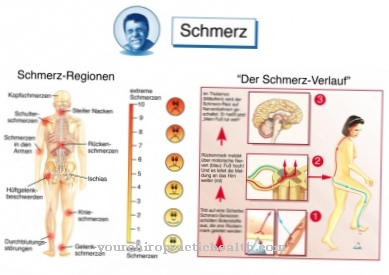Doesn't always come in Broken nose with externally visible deformations of the nose. However, in order to prevent complications occurring during the healing process, an early visit to the doctor can be useful.
What is a broken nose?

© miro kovacevic - stock.adobe.com
Of the Broken nose (in medicine also as Nasal bone fracture is one of the most common facial injuries. This is due, among other things, to the fact that the nose protrudes and that the bones of the nasal bone are relatively fine-bony; thus they can break under a comparatively light force.
A broken nasal bone is not always visible to the outside. However, when the nasal bone is broken, it can often be observed that the nose can be moved to a small extent. A nasal fracture often manifests itself initially as a severe swelling of the nose; in many cases this swelling is accompanied by severe pain after a while.
A broken nose is usually particularly painful to touch. In some cases, a broken nose can be accompanied by profuse bleeding from the nose.
causes
Is caused a Broken nose in most cases by external forces. For example, accidents and falls as well as physical attacks can be responsible for such forces.
Various sports with frequent body contact and high speeds (such as American football and of course boxing) are also associated with increased risks of breaking the nose.
A nasal bone fracture can also be deliberately brought about in the context of cosmetic operations: If the appearance of the nose is to be corrected, the bones of the nasal bone can be modeled accordingly after a fracture.
Symptoms, ailments & signs
A broken nose is associated with clear symptoms. At first, the nose usually starts bleeding profusely and the affected person feels severe pain. As a result, there is usually extensive swelling, as well as bruises and clearly visible changes in shape. The nose can be crooked and bumps and dents can form.
The patient's breathing is usually severely hindered by the bent nasal septum and swelling, and the ability to smell is not infrequently restricted. If individual bone fragments slip, the so-called "boxer's nose" is created, because in this case the bridge of the nose can sink in. In the event of strong violence, surrounding bones such as the ethmoid bone or the upper jawbone can also be affected by the fracture.
It is quite possible that symptoms such as bruising or swelling will not appear until a few hours after the accident. Therefore, only an actual tilt of the nose is a clear sign of a nasal bone fracture. In addition, the rupture often occurs with a septal hematoma.
These are bruises in the nasal septum caused by bleeding between the nasal mucosa and the cartilage. The bleeding causes the nasal septum to swell, which either hinders nasal breathing or makes it impossible.
A septal necrosis may occur as a possible complication. The tissue dies because the cartilage is no longer adequately supplied with blood. In addition, a bacterial hematoma infection is possible, which can lead to an abscess (accumulation of pus and a septal perforation (hole in the nasal septum).
Diagnosis & course
If the nose is deformed after the action of external force, this is a very reliable diagnosis Broken nose to. If the nose of a patient shows no deformation despite a suspected nasal fracture or if it is to be determined which bone areas are affected by a fracture, further examinations must be carried out.
For this purpose, for example, the inside of the nose can be viewed using what is known as rhinoscopy; In the context of rhinoscopy, the nasal openings are kept open with the help of medical instruments, while a doctor can view the inside of the nose with a light source. To diagnose a nasal bone fracture, the medical practitioner can also use the so-called palpation method: The outside of the nose is felt in order to be able to recognize, for example, mobility or broken edges.
As a rule, cartilage formation occurs very quickly in the broken bones of the nasal bone, so that the nasal bones are often reconnected after about 5 days. Appropriate medical measures help to ensure that a nasal bone fracture does not lead to malalignment of the nose or impaired breathing. Possible complications of open hernial wounds in a nasal bone fracture are infections as a result of invading pathogens.
Complications
A fracture of the nasal bone can of course also cause various complications, which should generally always be treated by an appropriate doctor. If a broken nose remains without any treatment, complications are inevitable. Often the fracture no longer grows together properly, which can lead to sharp and long-lasting pain.
The formation of an abscess is also possible. In such a case, extreme caution is required, because an abscess can cause very unpleasant consequential damage. With an abscess there is an increased accumulation of pus fluid. In some cases, the pus fluid enters the human bloodstream, which can even cause blood poisoning. If you want to avoid these complications right from the start, you shouldn't put off a visit to the doctor.
With early treatment, the above complications can be avoided. For this reason, a fracture of the nasal bone is of course associated with various complications, so that a visit to the doctor is inevitable. In this way, possible complaints and complications can be nipped in the bud. A complete and quick recovery is 100% guaranteed.
When should you go to the doctor?
If there is pain in the nose or deformation of the nose shape after an accident or fall, there is cause for concern. If the nose bleeds heavily, there are sensory disorders in the face or changes in the skin texture, the person concerned needs medical help. In the case of a broken nose, severe pain in the face area occurs even with a light touch, as well as in retirement. Usually the pain radiates over the entire face and extends into the head. This leads to disorders of concentration and attention. Thinking is limited because of the discomfort.
A doctor should be consulted so that there is no increase in symptoms and the existing pain is reduced. In order to avoid complications, you should refrain from taking any medication until you have consulted a doctor. A displacement of the nasal bones can be seen with mere visual contact and should be treated immediately.
The sooner a broken nose is medically treated, the better the healing process. If you bruise or if your breathing becomes difficult, a doctor is needed. A doctor should be consulted if there is a taste of blood in the mouth or swelling of the face. The symptoms lead to a further worsening of breathing activity, so that you have to hurry.
Treatment & Therapy
What medical treatment after a Broken nose becomes necessary depends initially on the shape of the nasal bone fracture: If the bones of the nasal bone have not shifted during a fracture, medical intervention is often not necessary; As a rule, the ends of the break join together again on their own.
However, since such a broken nasal bone can still be accompanied by severe pain and swelling, the treating doctor may occasionally prescribe pain-relieving medication. Immediately after a nasal bone fracture, cooling your nose quickly can help reduce the risk of swelling. If heavy bleeding occurs with a broken nasal bone that does not subside by itself, tamponades (dressing material that is inserted into the nostrils) may be necessary.
If the nose is deformed after a nasal bone fracture and bone fragments have shifted, a specialist will usually fix the fracture. In addition to the cosmetic direction, it must also be ensured that the airways are not impaired. If a broken nasal bone has to be repaired, it is important that the procedure is carried out quickly. If a treatment is delayed, the nasal bones may have already strengthened in a shifted position.
Outlook & forecast
A broken nose has an excellent chance of complete healing without permanent damage if treated as quickly as possible. In such cases, correct adjustment and treatment of the hernia can ensure that the nose heals undamaged within a few weeks. If the nasal bone is spared for another four to six weeks, the fracture of the nasal bone is then considered to have completely healed.
In other cases, in which the nasal bone fracture also affected other structures of the nose, the prognosis is even more dependent on rapid treatment. For example, if left untreated, a deformed septum is a risk of breathing and speech problems. In addition, a deformed septum almost always leads to snoring and an increased susceptibility to infections.
A detachment of the nasal mucous membrane from the nasal septum is also associated with a rather negative prognosis. This can lead to tissue death and bleeding, which visually can lead to a sunken nose. Rapid treatment improves the prognosis.
A broken nose can heal without treatment. However, there is then a very high chance that deformations will remain. These depend on the type of nasal bone fracture and the angle of the fracture. Most of the time, a boxer's nose or a crooked nose are left behind. In retrospect, this can only be corrected surgically.
prevention
One Broken nose as a result of accidents it is usually not possible to prevent. Appropriate protective clothing is used to prevent a broken nose in the context of risky sports. Complications can be prevented through the earliest possible medical diagnosis and treatment of a broken nose.
Aftercare
On the one hand, aftercare aims to prevent the symptoms from recurring. This cannot be the case for a broken nose, as sudden accidents and violence cannot be predicted.
However, patients can exercise a little more caution in everyday life if such an accident has happened to them. Certain types of sport are more prone to a new fracture. Masks can provide protection. If necessary, the doctor informs his patients about protective measures for which the person concerned is responsible.
On the other hand, there is a follow-up to ensure long-term treatment and everyday support. Often expected complications are associated with it.In the case of a broken nose, follow-up care lasts a good six weeks from the time of diagnosis; then the patient can continue his normal life.
Since then there is no symptoms, there is no follow-up care. An analysis of the acute symptoms is part of a check-up appointment. In addition, imaging tests can be used to determine the growth of the nasal bone. Drugs for pain relief are regularly prescribed.
You can do that yourself
To avoid permanent deformation of the nose, sufficient rest and rest is necessary after the doctor's visit. The instructions and recommendations of the doctor must be followed in order not to cause undesirable consequential damage.
Sports activities or intense physical activity should be avoided for the period of recovery. Situations in which violence or other physical attacks could occur should be averted in good time. Weights should not be lifted and jerky movements should be avoided. Hopping, jumping or running should be completely avoided during the healing phase. The movements can lead to unwanted bone displacement and triggering of pain.
Breathing should only be done through the mouth temporarily until the end of the treatment period. This prevents particles from the surrounding area and foreign bodies in the air from being absorbed into the nose. If the nose fills up with excessive nasal discharge, the head can be tilted back for a few minutes. The evacuation of the liquid is initiated via the throat and the painful blowing out is avoided. Wearing a mask can be found helpful and relieving. This is visually very noticeable in everyday life, protects the injured region very well from external influences.



.jpg)


.jpg)






.jpg)

.jpg)
.jpg)











.jpg)